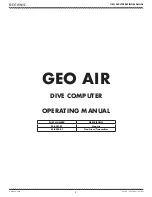
EngyVolt RV12
Appendix
35
11.1.6 Total harmonic distortion – THD
The calculation used for Total Harmonic Distortion is: THD = ((RMS of total waveform –
RMS of fundamental) / RMS of total waveform) x 100. This is often referred to as THD–R,
and lies in the range 0 to 100 %. THD measurement is subject to the 'range of use' limits.
The device may give erratic or incorrect readings where the THD is very high and the
fundamental is essentially absent. For low signal levels the noise contributions from the
signal may represent a significant portion of the “RMS of total waveform” and may thus
generate unexpectedly high values of THD. In this case the product will produce a display
of 0 (zero). Typically, display of THD will only produce the 0 (zero) value when the THD
calculation has been suppressed due to a low signal level being detected. It should also be
noted that spurious signals (for example, switching spikes) may be included in the “RMS of
the total waveform” and will be used in the calculation of THD. The display of THD may be
seen to fluctuate under these conditions.
11.1.7 Testing the phase sequence
The voltage and current inputs must be greater than 5 % of nominal for the test to operate
reliably.
In the 3 phase 4 wire operating mode the measured values are referenced from L1.
For the voltage sequence test, the phase of L2 relative to L1 must be within the window
240 ±48 degrees and L3 relative to L1 must be within the window 120 ±48 degrees to
record the sequence V123.
Alternatively, the phase of L2 relative to L1 must be within the window 120 ±48 degrees
and L3 relative to L1 must be within the window 240 ±48 degrees to record the sequence
V132.
For the current sequence test, the phase of I1 relative to L1 must be within the window 0
±48 degrees, I2 relative to L1 must be within the window 240 ±48 degrees, and I3 relative
to L1 must be within the window 120 ±120 degrees to record the sequence i123.
Alternatively the phase of I1 relative to L1 must be within the window 0 ±48 degrees, I2
relative to L1 must be within the window 120 ±48 degrees, and I3 relative to L1 must be
within the window 240 ±48 degrees to record the sequence i132.
In the 3 phase 3 wire operating mode measurements are referenced from L1-L2.
For the voltage sequence test, the phase of L2-L3 relative to L1-L2 must be within the
window 240 ±48 degrees L3-L1 relative to L1-L2 must be within the window 120 ±48
degrees to record the sequence V123.
Alternatively, the phase of L2-L3 relative to L1-L2 must be within the window 120 ±48
and L3 relative to L1-L2 must be within the window 240 ±48 degrees to record the
sequence V132.
For the current sequence test, the phase of I1 relative to L1-L2 must be within the window
330 ±48 degrees, I2 relative to L1-L2 must be within the window 210 ±48 degrees, and I3
relative to L1-L2 must be within the window 90 ±48 degrees to record the sequence i123.
Alternatively, the phase of I1 relative to L1-L2 must be within the window 330 ±48
degrees, I2 relative to L1-L2 must be within the window 90 ±48 degrees, and I3 relative to
L1-L2 must be within the window 210 ±48 degrees to record the sequence i132.
11.2 Modbus implementation
11.2.1 Modbus protocol overview
This section provides basic information for interfacing a multifunctional electrical energy
meter to a Modbus protocol network. If background information or more details of the
EngyVolt implementation is required please refer to the following sections of this
document. EngyVolt devices offer the option of an RS485 communication facility for direct
Содержание EngyVolt RV12
Страница 2: ......
Страница 27: ...EngyVolt RV12 Accessories 27 9 Accessories No accessories are available for this device...
Страница 61: ......
Страница 62: ......
Страница 63: ......
Страница 64: ...www addresses endress com...
















































